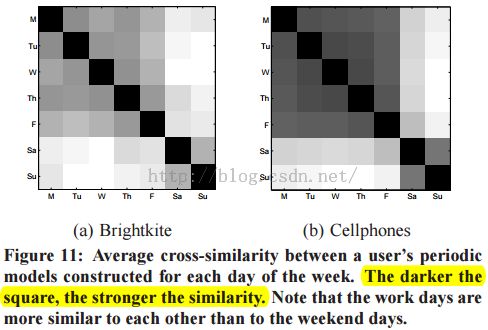社会友谊和人群移动:基于位置的社交网络中的用户移动(二)
上接前译文http://blog.csdn.net/ztf312/article/details/47143375
4. 人类移动模型
模型预测了人类移动的地理性(返回相同位置)和时空性(一天固定移动)
Periodic Mobility Model (PMM)移动预测模型:设置两个状态:上班、在家。一天当中,人们要么在工作单位、要么在家、要么往返途中。图6根据两个状态的中心建模,构成高斯分布,概率模型:一天当中每个时间段是否处于两个状态之一。
图6(a)在家用红色,上班用蓝色,图6(b)用户在家和单位移动的时空模型
概率公式:
用户u,在时间t,登陆地理位置x, 地理位置函数x(t). P[x(t)=x]描述了这种可能性. c(t)是状态函数,只有两个值:H为在家状态,W为工作状态。
t时刻用户的状态P[x(t)=x]是在家状态和工作状态的混合,混合因子由上述概率公式决定。
PMM模型的时空因素:t 时刻在家人数符合正态分布,taoH,taoW表示平均在家W、工作时间,因为一天是周期性的,为了方便起见,计算平均时间将中午 11:59到12:01 这两分钟除外。Pch是是时间上的独立可能性。
PMM模型的空间因素:
CSDN不方便编辑公式直接原文,covariance matrices意思是是协方差矩阵。
图7 (a)用户登陆的经纬度,(b)一天中登陆时间长短的可能性
Periodic & Social Mobility Model (PSMM)预测与社会模型
Zu(t)=1表示用户登录是社会性的(无周期性),Zu(t)=0表示用户登录是非社会性的(周期性),
Zu(t)=1条件下登陆xi的概率P由两个因素决定:距离朋友登陆的间隔时间,距离朋友登陆地点的距离。
PMM和PSMM模型的兼容性:模型参数定义,采用期望最大化,
图8 从家到单位的人员流动
图9 登陆时间和空间概率(a)用户登录的时间与最后一位朋友登陆相同地点的时间差(b)两个用户最后一次通话的距离差。
5.实验评估
评价指标:(a)不可见的测试集中的用户登录平均似然函数。(b)预测精度。
下面公式计算了,用户登录地点和模型计算出来的用户登录地点距离差的平均期望。
基准模型
三个没有测试的基准模型来比较:
(1)最频繁登陆位置概率模型(M)。尽管简单,很强大的一个对比模型。
|Cu|->正无穷,Pm会接近潜在的现实模型。
(2) 高斯模型(G)
给定一个星期的一天,N()中第一个参数是各个星期同一天的平均登陆位置,N()中第二个参数是协方差矩阵。
这个模型基于统计学,给出了用户活动范围。
(3) 下一移动位置模型(RW)
实验步骤:我们抽取一天中用户的至少10次登陆,80%在实验集,20%在测试集。这意味着抽取了6233个Brightkite用户,10997个Gowalla用户,853812个手机用户。对每个用户建立了七个模型对应一周的七天。
预测模型:首先我们比较了PMM模型和参照模型的性能,为简便起见我们只讨论Brightkite和手机用户。图10展示了四种模型结果。图10(c)和(d)给出了特使数据的对数似然矩阵结果。10(e)和(f)给出了预期相对距离差。
社会模型的预测性能:PSMM模型对PMM模型有所改进,提升了10%的相对期望距离差,
相似的日常移动模式:日常移动模式有相似性,我们进行了相似测量。C1,C2表示两个不同的登陆数据集,P1,P2表示PMM模型的计算结果。S函数类似于协方差矩阵的一个子集,可比较两个PMM模型,无论是统一用户不同日期登陆,还是不同用户同一天登陆。
潜在状态的数量:除了家和单位仍然可能有第三种状态。打个比方,在Brightkite,采用一个状态来预测精度为19.7%,两个状态精度为36.1%,相对提升了83.1%,三个状态精度则仅仅相对提升3.3%。
图11 平均相似性,方块越黑,则相似性越强。
6. 结论
我们发现用户小范围的移动具有时空周期性,不受社会结构影响,长距离的移动更容易受社会结构影响。还建立了一个动态模型,模拟了受人际关系影响的日常移动。可预测人类移动,
7.参考文献:
[1] L. Backstrom, E. Sun, and C. Marlow. Find me if you can: Improving geographical prediction with social and spatial proximity. In WWW ’10, pages 61–70, 2010.
[2] D. Brockmann, L. Hufnagel, and T. Geisel. The scaling laws of human travel. Nature, 2006.
[3] A. Clauset, C. R. Shalizi, and M. E. J. Newman. Power-law distributions in empirical data. SIAM Review, 2009.
[4] N. Couldry and A. Mccarthy. Mediaspace: Place, Scale and Culture in a Media Age (Comedia). Routledge, Nov. 2003.
[5] D. Crandall, L. Backstrom, D. Cosley, S. Suri, D. Huttenlocher, and J. Kleinberg. Inferring social ties from geographic coincidences. PNAS, 2010.
[6] J. Cranshaw, E. Toch, J. I. Hong, A. Kittur, and N. Sadeh. Bridging the gap between physical location and online social networks. In UbiComp, pages 119–128, 2010.
[7] N. Eagle and A. Pentland. Eigenbehaviors: Identifying structure in routine. Behavioral Ecology and Soc., 2009.
[8] N. Eagle, A. Pentland, and D. Lazer. Inferring friendship network structure by using mobile phone data. PNAS, 2009.
[9] S. Eubank, H. Guclu, V. S. Anil Kumar, M. V. Marathe, A. Srinivasan, Z. Toroczkai, and N. Wang. Modelling disease outbreaks in realistic urban social networks. Nature, 2004.
[10] E. Glaeser and M. Kahn. Sprawl and urban growth. Handbook of regional and urban economics, 2004.
[11] J. Goldenberg and M. Levy. Distance is not dead: Social interaction and geographical distance in the internet era. Arxiv, abs/0906.3202, 2009.
[12] M. C. Gonzalez, C. A. Hidalgo, and A.-L. Barabasi. Understanding individual human mobility patterns. Nature, 453(7196):779–782, 2008.
[13] Q. Hao, R. Cai, C. Wang, R. Xiao, J.-M. Yang, Y. Pang, and L. Zhang. Equip tourists with knowledge mined from travelogues. In WWW ’10, pages 401–410, 2010.
[14] T. J. Hatton and J. G. Williamson. Global Migration and the World Economy: Two Centuries of Policy and Performance. The MIT Press, 2008.
[15] L. Humphreys. Mobile social networks and social practice: A case study of dodgeball. Journal of Computer-Mediated Communication, 2008.
[16] B. Jiang, J. Yin, and S. Zhao. Characterizing the human mobility pattern in a large street network. Physical Review E, 80(2):021136, Aug. 2009.
[17] A. Kapoor, N. Eagle, and E. Horvitz. People, quakes, and communications: Inferences from call dynamics about a seismic event and its influences on a population. In AAAI Spring Symposiumg, 2010.
[18] M. Kim, D. Kotz, and S. Kim. Extracting a mobility model from real user traces. INFOCOM ’06, 2006.
[19] R. Lambiotte, V. Blondel, C. Dekerchove, E. Huens, C. Prieur, Z. Smoreda, and P. Vandooren. Geographical dispersal of mobile communication networks. Physica A, 387(21):5317–5325, Sept. 2008.
[20] K. Lee, S. Hong, S. J. Kim, I. Rhee, and S. Chong. SLAW: A new mobility model for human walks. In INFOCOM ’09, pages 855–863, 2009.
[21] T. Leighton. Improving performance on the internet. Queue, 6:20–29, 2008.
[22] J. Leskovec and E. Horvitz. Planetary-scale views on a large instant-messaging network. In WWW ’08, 2008.
[23] Z. Li, B. Ding, J. Han, R. Kays, and P. Nye. Mining periodic behaviors for moving objects. KDD ’10, 2010.
[24] D. Liben-Nowell, J. Novak, R. Kumar, P. Raghavan, and A. Tomkins. Geographic routing in social networks. PNAS, 2005.
[25] M. McPherson, L. Smith-Lovin, and J. M. Cook. Birds of a feather: Homophily in social networks. Annual Review of Sociology, 27(1):415–444, 2001.
[26] D. Mok, B. Wellman, and J. Carrasco. Does distance matter in the age of the internet? Urban Studies, 47(13), 2010.
[27] A. J. Nicholson and B. D. Noble. Breadcrumbs: Forecasting mobile connectivity. In MOBICOM ’08, pages 46–57, 2008.
[28] A. Noulas, S. Scellato, C. Mascolo, and M. Pontil. An empirical study of geographic user activity patterns in foursquare. In ICWSM ’11, 2011.
[29] S. Scellato, A. Noulas, R. Lambiotte, and C. Mascolo. Socio-spatial properties of online location-based social networks. In ICWSM ’11, 2011.
[30] C. Song, Z. Qu, N. Blumm, and A. Barabási. Limits of predictability in human mobility. Science, 2010.
[31] B. Wellman and K. Hampton. Living networked on and off line. Contemporary Sociology, 28(6):648–654, Nov. 1999.
[32] V. W. Zheng, Y. Zheng, X. Xie, and Q. Yang. Collaborative location and activity recommendations with GPS history data. In WWW ’10, pages 1029–1038, 2010.
[33] Y. Zheng, L. Zhang, X. Xie, and W.-Y. Ma. Mining interesting locations and travel sequences from GPS trajectories. In WWW ’09, pages 791–800, 2009.








